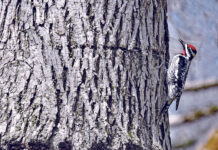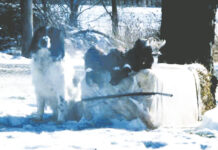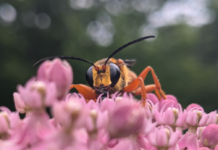Last year, the population of adult walleye in Lake Erie was estimated at 45 million. The estimate for this year is 116 million — a whopper of an increase at 257 percent.
That’s what the scientists say. Sam Downing, whose charter boat, the Pork Chop Express, trolls the waters of western Lake Erie, thinks they’re probably right.
Although limited to six customers at a time by COVID-19 restrictions, his boat had an incredible haul over Memorial Day weekend.
“We caught close to 300 walleye in four days,” he said.
Walleye
And they were caught in seemingly record time. On that Saturday, they left the dock at 6 a.m. and caught their limit by 10 a.m.
“The Lake Erie walleye population is dictated entirely by hatch strength,” said Eric Weimer, fishery biologist supervisor at the ODNR Division of Wildlife’s Sandusky Fisheries Research Station.
“Right now there are several years of the best walleye hatches we could ever hope for.”
The 2018 hatch was the largest since counts started in the 1980s. The 2019 hatch came in a close second. Those and the 2015 hatch were the best since the previous high point in 2003. That record 2018 hatch was largely responsible for the estimate of 116 million adult walleye in the lake in 2020.
“Adult” refers to a walleye that is two years or older.
Coincidentally — or maybe not — it takes about two years for walleye to reach 15 inches, the legal length for a “keeper.”
Thus, a big hatch two years ago means better walleye fishing now.
“We’ve got a bonanza of young fish out there from the 2018 hatch that will be starting to hit the 15-inch minimum this summer,” Weimer said. “There are a lot of mouths out there, so the fishing should be great.”
“I do agree, the last two years have been phenomenal,” said Capt. Sam, whose first mate is his son, Caleb, a rising junior at the Marine Military Academy in Texas.
“In previous years, I had to work harder, search longer and fish longer.”
This is Downing’s third year running a charter, but his 20th year of angling. He said the fishing on Lake Erie is “as good as I’ve ever seen, maybe better.”
History
For long-time devotees of Lake Erie fishing, “ever” doesn’t go back all that far. Those who are old enough remember when the lake was a brown, murky mess that often had an unpleasant odor. It became part of a national joke when the Cuyahoga River — which flows into Lake Erie in Cleveland — caught fire in 1969.
But that helped spur the Clean Water Act of 1972.
“The Clean Water Act made the lake livable again,” Weimer said. “Walleye numbers recovered to high levels by the 1980s.”
So when he and his colleagues hear people talk about “the good old days” of fishing on Lake Erie, that’s what they’re referring to: That time about 40 years ago when fish populations began to rebound from decades of pollution.
But Weimer and other fishery scientists think the dramatic increases in walleye numbers will make these “the good old days” when grizzled veterans of the weapons-and-worm wars reminisce in the decades to come.
“Just think, the fishing has been good for two years based on the smaller 2014- and 2015-year hatches,” Weimer said. “When the 2018- and 2019-year hatches make it to 15 inches, it is going to be phenomenal.”
Surveys
Exactly how do scientists determine the number of walleye that have hatched in a given year? Trawl surveys.
A funnel-shaped net with heavy boards to weigh it down is dragged along the bottom for 10 minutes at each site, with the boat going between 1 1/2 and 2 mph.
The net is winched up and dumped on a sorting table. These surveys are done with agencies in Ontario and Michigan to come up with numbers of hatchlings per hectare (there are about 2.5 acres in a hectare) for the entire lake for that year.
The surveys are done from May through September, but the most important one is in late August.
“We’re indexing the hatch strength of walleye and yellow perch especially,” Weimer said.
It’s not illogical to think that record hatch rates of walleye might lead to record harvests, especially since anglers seem to be catching their limit in a shorter amount of time.
The Division of Wildlife determines the size of the yearly harvests with the help of creel clerks, Weimer said. Each clerk is assigned a section of the lake, from Michigan clear to the Pennsylvania state line. They go to marinas and boat launches and count boats and trailers.
They interview anglers, asking a series of questions: How many fish were caught? How many released?
They also check some of the fish caught to determine their size and age. These surveys normally go on from spring through fall. This spring, the COVID-19 crisis prevented the creel clerks from starting their work, but they are hoping restrictions will be lifted soon, Weimer said.
When the clerks complete their surveys, the Division of Wildlife and its partner agencies will do a harvest estimate.
Limits
That, in addition to the population estimate, forms the basis for daily bag limits. Currently, it’s six walleye per person per day. It has yet to be determined how much the COVID-19 crisis will affect the harvest.
In the past two months, many people discovered that fishing is something they can do while socially distancing. And now they had the time to do it. Boat launches and fishing piers became jammed to the point that some were shut down briefly.
The Division of Wildlife also suspended sales of out-of-state fishing licenses for a time.
In mid-May, Cleveland’s Channel 5 reported that Parma Marine was seeing its highest boat sales since the business opened in 1953.
Manager Joel Morrison said the COVID-19 crisis has “motivated” people to get into recreational boating. And Parma Marine is not alone.
Downing may have seen the recent increase in boat sales first hand over Memorial Day weekend. “We fished Saturday off Catawba Island, and I probably saw 150 recreational boats go past us in the afternoon,” he said.
A lot of those boats contained anglers. Plus, charter boats like Downing’s were able to resume operations in recent weeks, although they are limited in the number of customers they can have on board at one time.
The increase in walleye population, plus increased popularity of fishing due to the COVID crisis, might very well equal greater harvest numbers for 2020.
And if that’s the case, scientists say, better walleye fishing on Lake Erie won’t just be a flash in the pan.
“Walleye can live a lot longer than people think,” Weimer said. “It’s not unusual to find a walleye aged over 20 years.”
Age
Believe it or not, biologists can tell how old a fish is by counting the rings in the otolith, a structure found in the fish’s inner ear. It’s like counting the rings on a tree.
If recent hatchlings can live a couple of decades, “it’s not only a benefit in the short term, but will benefit the fishery for many years to come,” Weimer said.
He points to a spike in the adult walleye population in 2005 because of the 2003 hatch, the third largest since the counts began.
“That year’s class carried our fishery for a long time, so we are expecting the ’18- and ’19-year classes to do the same,” he said.
That’s good news to Downing, who is pretty happy with the way walleye fishing is going now.
“Lake Erie is just a good place to go fishing,” he said. “Anyone who fishes now is going to have a lot of good fish to take home for meals.”
Weimer is glad to hear that anglers’ experiences seem to be confirming scientists’ predictions.
“Last year was great and this year there are going to be even more fish coming into the fishery, so the fishing will be as good as it can be,” Weimer said. “From a fishery biologist’s perspective, it’s pretty easy to justify that these are the good old days.”













